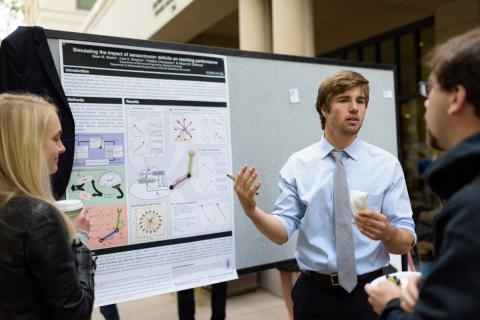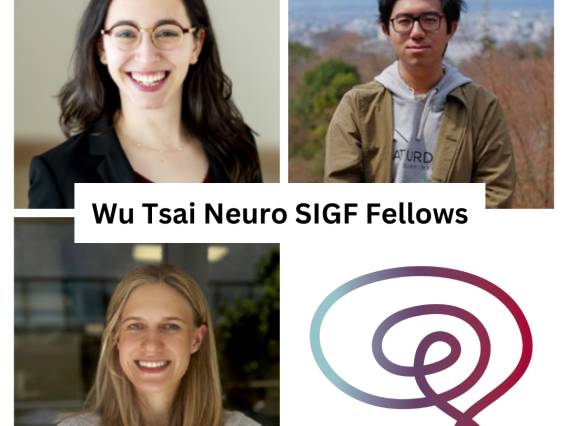Training the next generation of interdisciplinary neuroscientists
The Stanford Interdisciplinary Graduate Fellowship (SIGF) is a competitive, university-wide program that awards three-year fellowships to outstanding doctoral students engaged in interdisciplinary research. Three independent institutes, Bio-X, Wu Tsai Neurosciences Institute, and Sarafan ChEM-H award these graduate fellowships in the biosciences.
The Wu Tsai Neurosciences Institute partners with the Vice Provost for Graduate Education and Stanford BioX to award Stanford Interdisciplinary Graduate Fellowships (SIGFs) in the area of neuroscience. We are grateful to Bio-X and the Bio-X Leadership Council for incorporating the fellowships affiliated with the Institute into their application process.
Learn more about application details and eligibility criteria.
2025 SIGF Application
All applications submitted through the portal will be considered for the Stanford Interdisciplinary Graduate Fellowships (SIGFs) affiliated with the Wu Tsai Neurosciences Institute or Sarafan ChEM-H, the Bio-X SIGFs, and the Stanford Bio-X Bowes Fellowships.
Funded SIGF projects
Uncovering the neurochemical basis of colonic water absorption
Constipation and diarrhea, caused by aberrant water absorption in the colon, impose substantial health burdens. The enteric nervous system (ENS) harbors a specialized circuit for water absorption, the secretomotor/vasodilator circuit, but its role in the proximal colon remains poorly understood.
Uncovering behavior-dependent entorhinal maps with state space models
The medial entorhinal cortex (MEC), the brain’s “inner GPS”, contains an internal map of external space. Rather than representing a static spatial map, however, MEC neurons can spontaneously switch between multiple maps (Low et al., 2021). In this project, we will investigate if spontaneous map switches reflect changes in an animal’s latent internal state.
Uncovering the roles of representational drift in the brain through the lens of dynamical systems and their practical implications in brain-computer interfaces
Understanding representational drift—the brain’s evolving representation of its environment—is pivotal to gaining insights into neural computation. Despite its significance, the study of representational drift has been constrained by the scarcity of suitable datasets and methods.
Engineering objective physiologic measures to characterize nonmotor aspects of Parkinson’s disease
Parkinson’s disease (PD) is a complex, heterogeneous neurodegenerative disorder whose prevalence is increasing rapidly. Not only do patients experience motor symptoms, but many experience debilitating nonmotor symptoms caused by peripheral degeneration in the autonomic nervous system, including atrophy of the vagus nerve, and the enteric nervous system.
A principled investigation into the heterogeneous coding properties of medial entorhinal cortex that support accurate spatial navigation
Navigation through an environment to a remembered location is a critical skill we use every day. How does our brain accomplish such a task? Over the last few decades, several lines of evidence have suggested that a brain region called medial entorhinal cortex (MEC) supports navigation by encoding information our location and movement within an environment.
Elucidating mechanisms of microglial tiling
In a process called tiling, homeostatic microglia homogenously organize in a grid-like fashion to achieve efficient surveillance of the brain. The molecular mechanisms underlying tiling are unknown. I hypothesize that microglia use cell-surface proteins to sense density of neighboring microglia, thereby contributing to constant cell-to-cell distances.
Neural mechanisms of learning multiple motor skills and implications for motor rehabilitation
A hallmark of the motor system is its ability to execute different skilled movements as the situation warrants, thanks to the flexibility of motor learning. Despite many behavioral studies on motor learning, the neural mechanisms of motor memory formation and modification remain unclear.
Mechanistic insights into glycerophospholipid metabolism in the lysosome
Phospholipid dysregulation is implicated in the pathogenesis of lysosomal storage disorders (LSDs). We found that glycerophosphodiesters (GPDs) accumulate in lysosomes derived from Batten disease models, a life-limiting LSD whose pathological mechanism remains elusive. GPDs are the degradation products of glycerophospholipid catabolism by phospholipases.





